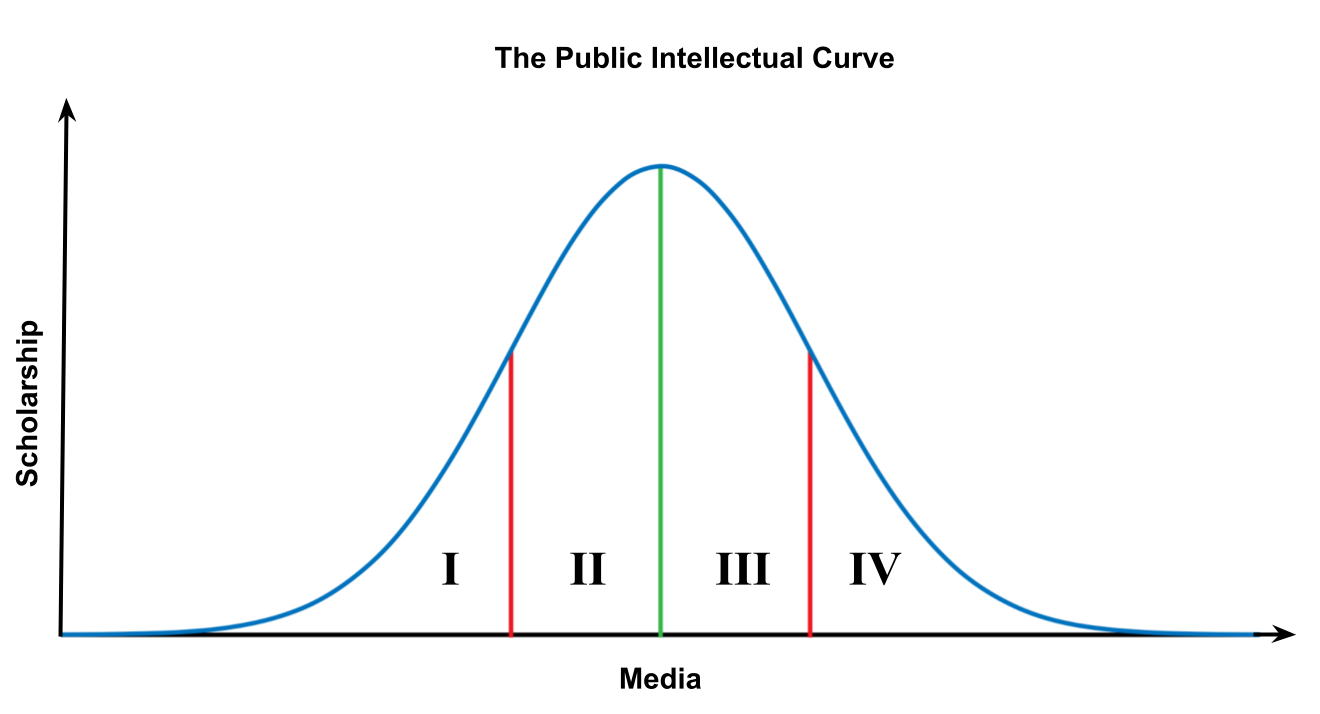The Volokh Conspiracy
Mostly law professors | Sometimes contrarian | Often libertarian | Always independent
The Arc Of The "Public Intellectual"
I've long been fascinated by the concept of the "public intellectual." I view this person as embodying two characteristics: first, an intellectual, as measured by scholarship; second, a public-facing scholar, as measured by media exposure. Generally, the press will not give an opportunity to a scholar unless she has already achieved a threshold level of scholarship. However, a person who achieves "public intellectual" status will invariably see a dip in scholarship, even if the media machine continues to churn.
The arc of a public intellectual's career can be represented on a graph. On the y-axis is scholarship. On the x-axis is media exposure.
The overwhelming majority of scholars never even make it onto the curve. Their work, while important for the literature, may not have resonance in public discourse. And for good reason. The best scholarship focuses on ideas for the sake of ideas, not based on what gets the most clicks. Moreover, most professors choose not to do media. It is time-consuming, and seldom contributes to a scholarly agenda. Professors can choose many other forms of service.
Some professors will gravitate--by chance or by choice--towards scholarship that touches on the zeitgeist. And if their publications meet some threshold of quality, the media calls will begin. I refer to this area as Zone I. Here, a professor's greatest contribution is still to the literature, but she is increasingly called upon to speak to the press. Scholars may spend their entire careers in Zone I: publishing quality scholarship, and talking to the media on occasion. This is a career well-spent. But other scholars may ride up the curve.
In Zone II, professors continue to publish important scholarship, as they become fixtures in the press. At some threshold, they become the coveted public intellectual. The academic community reads and respects their scholarship, while elite institutions of media routinely call on them. The professors may choose to publish books with a popular press, rather than an academic press. And invariably, popular presses will push authors to be more edgy, and less scholarly. Footnotes do not sell books. On a book tour, they'll give lectures to academic and non-academic audiences. Perhaps they will receive a regular column in a magazine or newspaper, that blends their academic curiosities with the news of the day. Or they'll become a paid contributor on TV or radio. Media producers, like editors, also demand edginess. But at least for a time, as their media profile grows, they can maintain their scholarly output, as well as teaching and other service obligations. Perhaps some public intellectuals can spend their entire careers in Zone II. Alas, for everyone else, all good things come to an end.
Zone III represents the decline. Public intellectuals will spend more and more time on the "public" part of their job, and less time on the "intellectual" work. Dedicating hours to writing op-eds, popular books, recording podcasts, and (gasp) tweeting will necessarily take away time from academic scholarship. Often this decline can be masked. Public intellectuals can hire an army of super-smart research assistants who can prop up their scholarship. Or they will co-author with junior scholars who do the bulk of the work, but list their name second on the author block. But these scholars will seldom have the devoted time and space that allowed them to develop their intellectual bona fides in the first place. Alas, the press doesn't actually care if a person's scholarship slips. Public intellectuals can tread on their work from decades earlier, as the media continues to call. Thus, in Zone III, even as a professor's scholarship drops, the media exposure increases. There is a vicious cycle: the more a public intellectual seeks the public spotlight, the scholarly community regards her work less. And eventually, even Zone III comes to an end.
Zone IV represents the final chapter of a public intellectual's career. After many years of declining scholarship, the professor is almost exclusively a media figure. Sure, she may publish things from time-to-time. Professors with high profiles can leverage their reputations to secure publications, such as invited pieces and symposium essays. But the professor becomes something of a has-been in scholarly debates. Yet, remarkably, the media keeps calling! Reporters are more interested in punchy lines than citable papers. Moreover, in this zone, the public intellectual may become more strident. Rather than using a scholarly tone, she will will sound not much different than a pundit on cable news who lacks an endowed chair. And often, due to aging, judgment and discretion begin to slip. These professors will cross lines they would have never crossed years earlier. At some point, the cycle concludes.
***
I have been very careful not to identify any scholars in particular, and where they fall on the curve--myself included. I'm sure readers will try to plot me and others on the graph.

Show Comments (41)